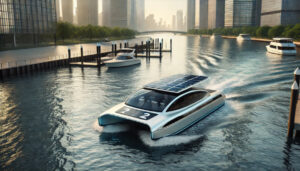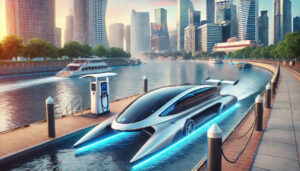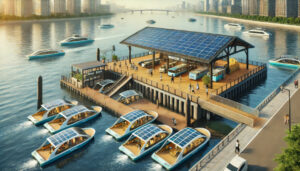The Water Taxi Market is gaining traction as a sustainable and efficient mode of transportation in urban and tourist-centric regions. With increasing congestion in road-based transportation and a growing emphasis on eco-friendly alternatives, water taxis provide an effective solution for ferrying passengers across rivers, lakes, and coastal areas. The rising adoption of electric and hybrid water taxis, along with government initiatives to improve water transport infrastructure, is driving significant market growth.
This market is shaped by advancements in maritime technology, growing investments in clean energy solutions, and increasing demand for smart mobility solutions. As cities aim to integrate water-based transport systems into urban planning, the Water Taxi Market is expected to witness rapid expansion.
Growth Drivers
The Water Taxi Market is experiencing strong growth due to the increasing need for alternative transport solutions that reduce congestion and carbon emissions. Several key factors are contributing to this expansion.
The increasing urbanization and rising population in metropolitan areas are pushing governments to seek sustainable transport solutions. Many cities are incorporating water taxis into their public transportation networks to enhance connectivity and decongest roads. This shift toward water-based mobility is promoting the development of advanced infrastructure, such as dedicated docking stations and automated ticketing systems.
Technological advancements in electric propulsion systems are revolutionizing the market. The adoption of electric and hybrid water taxis is on the rise, driven by stringent environmental regulations and the need to reduce fuel costs. Innovations in battery technology and charging infrastructure are improving operational efficiency, making electric water taxis a viable alternative to traditional fuel-powered vessels.
Tourism and leisure activities are another major factor propelling the Water Taxi Market forward. Popular tourist destinations with extensive waterfronts are increasingly using water taxis to offer scenic travel experiences. This trend is fueling demand for luxurious and customized water taxis equipped with advanced safety features, smart navigation systems, and comfortable seating.
Download Pdf Brochure: https://www.marketsandmarkets.com/pdfdownloadNew.asp?id=264760668
Market Challenges
Despite its growth, the Water Taxi Market faces challenges that need to be addressed. The high initial investment required for water taxi fleets, charging stations, and infrastructure development poses a significant hurdle for operators. Additionally, maintenance costs and regulatory requirements for water transport systems can be complex and vary across regions, creating entry barriers for new players.
Weather dependency is another major challenge. Unlike road-based transport, water taxis are more susceptible to adverse weather conditions such as heavy rains, storms, and high tides. These factors can lead to service disruptions and operational inefficiencies.
Opportunities in the Market
The Water Taxi Market presents several lucrative opportunities. Governments and private stakeholders are investing in smart and autonomous water taxis to enhance efficiency and safety. The development of AI-powered navigation systems and remote monitoring capabilities is expected to boost the adoption of autonomous water taxis in the coming years.
Increasing investments in sustainable maritime infrastructure offer significant growth prospects. Public and private initiatives aimed at developing clean energy solutions for water-based transport are expected to accelerate the transition toward greener water taxis. Hydrogen fuel cells and solar-powered water taxis are emerging as promising alternatives to conventional propulsion systems.
Market Segmentation
The Water Taxi Market is segmented based on propulsion type, fuel type, application, and region.
Electric and hybrid propulsion water taxis are gaining momentum as cities worldwide aim to reduce emissions and enhance energy efficiency. Diesel-powered water taxis continue to dominate the market due to their high fuel efficiency and longer range; however, their environmental impact is pushing manufacturers to explore cleaner alternatives.
The market is also segmented based on application, including urban transport, tourism, and commercial use. The tourism segment holds a significant share due to increasing waterfront-based tourism activities. Water taxis are becoming an integral part of tourism strategies, offering visitors a unique way to explore coastal cities and island destinations.
Regional Analysis
North America is a key market for water taxis, driven by increasing government support for water-based transport solutions in cities such as New York, Miami, and San Francisco. The presence of well-established infrastructure and high adoption of electric water taxis contribute to the region’s growth.
Europe is another major player in the market, with countries like the Netherlands, Italy, and the UK leading the way in sustainable water transport solutions. Government initiatives to reduce carbon footprints and promote clean mobility are fostering demand for electric and hybrid water taxis.
The Asia-Pacific region is expected to witness the highest growth rate due to rapid urbanization and increasing investments in maritime transport infrastructure. Countries such as China, Japan, and India are exploring water taxi services to enhance urban connectivity and reduce road congestion.
Competitive Landscape
The Water Taxi Market is highly competitive, with several key players driving innovation and expansion. Leading companies are focusing on developing energy-efficient and smart water taxis equipped with advanced safety and navigation systems.
Prominent companies in the market include:
- Uber Boat (UK): Providing water taxi services in London, offering seamless connectivity along the River Thames.
- Aqua Taxi (US): Specializing in water taxi services for urban commuters and tourists.
- Venice Water Taxi (Italy): A leading operator in the luxury water transport segment, catering to tourists in Venice.
- Electric Boats Ltd (Netherlands): Innovating in the electric water taxi segment, promoting eco-friendly transport solutions.
- Candela (Sweden): Developing high-performance electric water taxis with hydrofoil technology for enhanced efficiency.
Ask For Sample Report: https://www.marketsandmarkets.com/requestsampleNew.asp?id=264760668
Future Trends
The Water Taxi Market is expected to witness rapid technological advancements. The development of autonomous water taxis, AI-powered fleet management, and smart ticketing systems will redefine the industry. The adoption of sustainable fuel alternatives, such as hydrogen and solar energy, will further enhance operational efficiency and environmental sustainability.
Growing collaborations between governments and private enterprises are set to drive infrastructure development, making water taxis an integral part of multimodal transport systems. The expansion of smart cities and increased investments in maritime transport solutions will further propel market growth.
The Water Taxi Market is poised for significant expansion, driven by increasing urbanization, environmental concerns, and advancements in maritime technology. While challenges such as high infrastructure costs and weather dependency persist, the market presents immense growth opportunities. With strong government support, rising consumer demand for sustainable transport, and ongoing technological innovations, water taxis are set to play a crucial role in the future of urban mobility.


